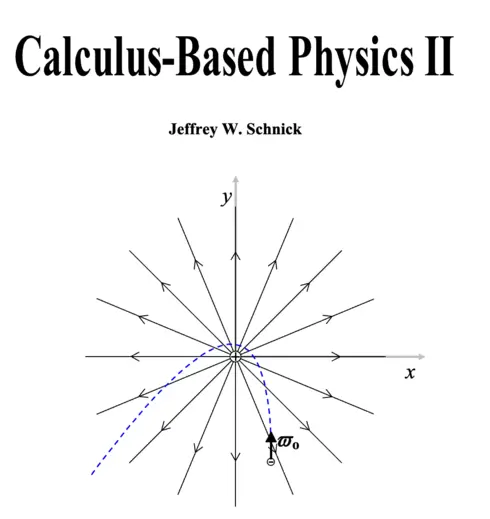
Calculus-Based Physics II
![]()
![]()
![]()
![]()
![]()
Jeffrey Schnick, Saint Anselm College
Copyright Year:
Publisher: Jeffrey W. Schnick
Language: English
Formats Available
Conditions of Use
![]() Attribution-ShareAlike
Attribution-ShareAlike
CC BY-SA
Reviews
Reviewed by Elena Kuchina, Professor, Thomas Nelson Community College on 3/22/19
Calculus-Based Physics II by Jeffery W. Schnick briefly covers each topic students would cover in a second semester of calculus-based physics course that does not cover modern physics. The chapters are written in lecture notes style with a couple... read more
![]()
![]()
![]()
![]()
![]()
Reviewed by Elena Kuchina, Professor, Thomas Nelson Community College on 3/22/19
Comprehensiveness
Calculus-Based Physics II by Jeffery W. Schnick briefly covers each topic students would cover in a second semester of calculus-based physics course that does not cover modern physics. The chapters are written in lecture notes style with a couple of example problems for the students to work through. Homework problems are collected in a different document and the coordination between them is not very straight forward. For students taking calculus-based physics, knowledge beyond the very basic concepts and examples of practical application of principles could be helpful, as well as additional examples of problem solving.
Content Accuracy
I noticed no errors in the presented physics or calculations.
Relevance/Longevity
Physics covered in a typical introductory course is well established and is not going to change much. Only advances are expected, but they are covered in the Modern Physics section of the course and not covered by this textbook. The text is written in a easy to follow language, while following the order may raise some concerns.
Clarity
The book reads easily, and contains diagrams, pictures, and step-by-step mathematical derivation of some results.
Consistency
The text is internally consistent in terms of terminology and framework.
Modularity
Each chapter is about 10 pages long, which makes assigning reading for the students easy. If the student uses this textbook for this semester only, some math remediation and review of topics covered in the first semester would be needed, at least at the end of the book. The order of the book is unconventional for some reason such that some topics are left out until the very end of the semester, while are essential for introductory physics course.
Organization/Structure/Flow
The book has an unconventional order of topics, as if some chapters are left out until last moment to be covered if time allows (chapters 30-37) .
Interface
I like the details and remarkable effort to make a three-dimensional images. Many pictures are shown in "progression", step-by-step, as the instructor would demonstrate it on the board, adding elements of problem-solving process. They are a little too big in my opinion but easy to follow. For the reference purposes, the captions for the pictures would help if this book would be considered as an independent source of information and beyond the instructor reference material. The structure of the text is easy to follow.
Grammatical Errors
I did not notice any grammatical errors.
Cultural Relevance
The text is not culturally insensitive or offensive in any way, reflecting the essence of physics knowledge.
CommentsThe book would also be useful for non-physics major willing to see how calculus is applied to better understand some physical phenomena. As mentioned before, more content needs to be added for the students to develop an in-depth understanding of the topics covered in an introductory calculus-based physics course to be suitable for scientists and engineers.I would use this book if a a brief overview of electricity, magnetism and optics is needed or as a reference and lecture planning tool.
Table of Contents
- 1 Charge & Coulomb's Law
- 2 The Electric Field: Description and Effect
- 3 The Electric Field Due to one or more Point Charges
- 4 Conductors and the Electric Field
- 5 Work Done by the Electric Field, and, the Electric Potential
- 6 The Electric Potential Due to One or More Point Charges
- 7 Equipotential Surfaces, Conductors, and Voltage
- 8 Capacitors, Dielectrics, and Energy in Capacitors
- 9 Electric Current, EMF, Ohm's Law
- 10 Resistors in Series and Parallel; Measuring I & V
- 11 Resistivity, Power
- 12 Kirchhoff's Rules, Terminal Voltage
- 13 RC Circuits
- 14 Capacitors in Series & Parallel
- 15 Magnetic Field Intro: Effects
- 16 Magnetic Field: More Effects
- 17 Magnetic Field: Causes
- 18 Faraday's Law, Lenz's Law
- 19 Induction, Transformers, and Generators
- 20 Faraday's Law and Maxwell's Extension to Ampere's Law
- 21 The Nature of Electromagnetic Waves
- 22 Huygens's Principle and 2-Slit Interference
- 23 Single-Slit Diffraction
- 24 Thin Film Interference
- 25 Polarization
- 26 Geometric Optics, Reflection
- 27 Refraction, Dispersion, Internal Reflection
- 28 Thin Lenses: Ray Tracing
- 29 Thin Lenses: Lens Equation, Optical Power
- 30 The Electric Field Due to a Continuous Distribution of Charge on a Line
- 31 The Electric Potential due to a Continuous Charge Distribution
- 32 Calculating the Electric Field from the Electric Potential
- 33 Gauss's Law
- 34 Gauss's Law Example
- 35 Gauss's Law for the Magnetic Field, and, Ampere's Law Revisited
- 36 The Biot-Savart Law
- 37 Maxwell's Equations
About the Book
Calculus-Based Physics is an introductory physics textbook designed for use in the two-semester introductory physics course typically taken by science and engineering students.
About the Contributors
Author
Jeffrey Schnick, PhD is an assistant professor at Saint Anselm College.
